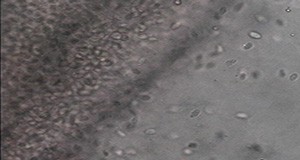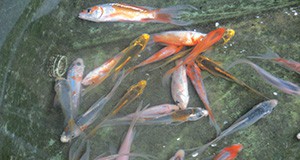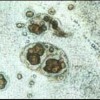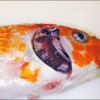
A group of species of single-celled parasites called Spironucleus cause disease in aquacultured and captive fish. Found in cold, temperate, and tropical climates, Spironucleus species can infect a variety of freshwater and marine ornamental and food fish, as well as crustaceans and shellfish.
Five species of Spironucleus are currently recognized: S. salmonicida, S. barkhaus, and S. torosa can infest marine organisms, while S. salmonis and S. vortens can infest freshwater ornamental fish. This four-page fact sheet written by Ruth Francis-Floyd and Roy P. E. Yanong and published by the Department of Large Animal Clinical Sciences focuses on S. vortens and its effects on ornamental cichlids, explaining which cichlids are susceptible, how to identify S. vortens , and how to confirm, manage, and prevent S. vortens infestations. (Photo credit: Roy P. E. Yanong, UF/IFAS Extension Tropical Aquaculture Laboratory)
http://edis.ifas.ufl.edu/vm053
Tag: Fish Diseases
Carp Edema Virus Disease (CEVD) / Koi Sleepy Disease (KSD)

Carp edema virus disease is killing wild and cultured varieties of carp and worrying koi enthusiasts and carp aquaculturists in the United States and around the world. The disease causes skin lesions and swelling and is sometimes called “koi sleepy disease” because infected fish become lethargic and unresponsive. This 5-page fact sheet describes symptoms, diagnosis, prevention, and what fish producers, wholesalers, or retailers can do if they suspect carp may have contracted the disease. Written by Shohreh Hesami, Pedro Viadanna, Natalie Steckler. Staci Spears, Patrick Thompson, Karen Kelley, Roy Yanong, Ruth Francis-Floyd, Johnny Shelley, Joseph Groff, Andy Goodwin, Olga Haenen, and Thomas Waltzek, and published by the School of Forest Resources and Conservation Program in Fisheries and Aquatic Sciences.
http://edis.ifas.ufl.edu/fa189
Cryptobia iubilans in Cichlids
 After many years of diagnostics at the University of Florida and at other laboratories around the country, it appears that Cryptobia iubilans is not uncommon among cichlids, and that environmental and other factors determine the extent of disease.This 3-page fact sheet was written by Ruth Francis-Floyd and Roy Yanong, and published by the UF Department of Fisheries and Aquatic Sciences, September 2014.
After many years of diagnostics at the University of Florida and at other laboratories around the country, it appears that Cryptobia iubilans is not uncommon among cichlids, and that environmental and other factors determine the extent of disease.This 3-page fact sheet was written by Ruth Francis-Floyd and Roy Yanong, and published by the UF Department of Fisheries and Aquatic Sciences, September 2014.
http://edis.ifas.ufl.edu/vm077
Koi Herpesvirus Disease (KHVD) (VM149/VM113)
 Koi herpesvirus (KHV) is a highly contagious virus that causes significant morbidity and mortality in common carp varieties. Common carp is raised as a foodfish in many countries and has also been selectively bred for the ornamental fish industry where it is known as koi. The first recognized case of KHV occurred in the United Kingdom in 1996. Since then other cases have been confirmed in almost all countries that culture koi and/or common carp with the exception of Australia. This 9-page fact sheet is intended to inform veterinarians, biologists, fish producers and hobbyists about KHV disease. Written by Kathleen H. Hartman, Roy P.E. Yanong, Deborah B. Pouder, B. Denise Petty, Ruth Francis-Floyd, Allen C. Riggs, and Thomas B. Waltzek, and published by the UF Department of Fisheries and Aquatic Sciences, April 2013.
Koi herpesvirus (KHV) is a highly contagious virus that causes significant morbidity and mortality in common carp varieties. Common carp is raised as a foodfish in many countries and has also been selectively bred for the ornamental fish industry where it is known as koi. The first recognized case of KHV occurred in the United Kingdom in 1996. Since then other cases have been confirmed in almost all countries that culture koi and/or common carp with the exception of Australia. This 9-page fact sheet is intended to inform veterinarians, biologists, fish producers and hobbyists about KHV disease. Written by Kathleen H. Hartman, Roy P.E. Yanong, Deborah B. Pouder, B. Denise Petty, Ruth Francis-Floyd, Allen C. Riggs, and Thomas B. Waltzek, and published by the UF Department of Fisheries and Aquatic Sciences, April 2013.
http://edis.ifas.ufl.edu/vm113
Megalocytivirus Infections in Fish, with Emphasis on Ornamental Species (FA182)
Megalocytiviruses cause systemic infections that can result in moderate to heavy losses in many different species of freshwater and marine fishes in both cultured and wild stocks. This 8-page fact sheet was written by Roy P. E. Yanong and Thomas B. Waltzek, and published by the UF Department of Fisheries and Aquatic Sciences, December 2010.
http://edis.ifas.ufl.edu/fa182
Lymphocystis Disease in Fish (FA181/FA181)
Lymphocystis is a chronic disease of freshwater and marine fishes caused by infection with an iridovirus known as Lymphocystivirus or Lymphocystis disease virus (LCDV). Infection results in the development of pebble or wart-like nodules most commonly seen on the fins, skin, or gills, although other tissues may be affected. This 5-page fact sheet was written by Roy P. E. Yanong, and published by the UF Department of Fisheries and Aquatic Sciences, December 2010.
http://edis.ifas.ufl.edu/fa181
Viral Nervous Necrosis (Betanodavirus) Infections in Fish (FA180/FA180)
The betanodaviruses are an important, emerging group of viruses known to infect over 40 marine fish species worldwide. This 7-page fact sheet was written by Roy P. E. Yanong, and published by the UF Department of Fisheries and Aquatic Sciences, December 2010.
http://edis.ifas.ufl.edu/fa180
FA164 Cryptocaryon irritans Infections (Marine White Spot Disease) in Fish
FA164, a 10-page illustrated fact sheet by Roy P. E. Yanong, describes this significant disease problem for marine aquarists and commercial mariculture worldwide — signs of disease, biology and life cycle, immunity, diagnostics, prevention and control, disinfection, and biosecurity considerations. Includes references. Published by the UF Program in Fisheries and Aquatic Sciences, December 2009.
http://edis.ifas.ufl.edu/fa164
VM-149/VM113 Koi Herpesvirus (KHV) Disease
Revised! VM-149, a 9-page illustrated fact sheet by Kathleen H. Hartman, Roy P.E. Yanong, Deborah B. Pouder, B. Denise Petty, Ruth Francis-Floyd and Allen C. Riggs, informs veterinarians, biologists, fish producers and hobbyists about the KHV disease in a question-and-answer format. Includes glossary and references. Published by the UF College of Veterinary Medicine, October 2008.
http://edis.ifas.ufl.edu/VM113